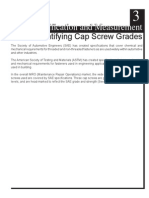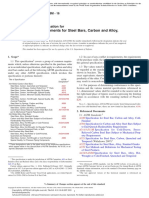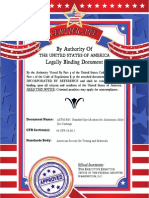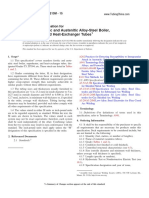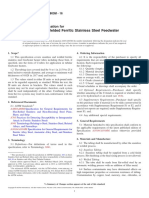QQ P 35C
QQ P 35C
Uploaded by
geverett2765Copyright:
Available Formats
QQ P 35C
QQ P 35C
Uploaded by
geverett2765Original Title
Copyright
Available Formats
Share this document
Did you find this document useful?
Is this content inappropriate?
Copyright:
Available Formats
QQ P 35C
QQ P 35C
Uploaded by
geverett2765Copyright:
Available Formats
QQ-P-35C October 28, 1988 SUPERSEDING Fed. Spec.
QQ-P-35B April 5, 1973 FEDERAL SPECIFICATION PASSIVATION TREATMENTS FOR CORROSION-RESISTANT STEEL This specification was approved by the Assistant Administrator Office of Federal Supply and Services, General Services Administration, for the use of all Federal Agencies. 1. SCOPE AND CLASSIFICATION 1.1 Scope. This specification covers the different types of passivation treatments as well as recommendations, guidance and precautions for cleaning and descaling corrosion-resistant parts, components, equipment and systems. 1.2 Purpose. This specification covers the method for cleaning and descaling of stainless steel parts and outlines the final cleaning stage or passivation treatments for use on austenitic, ferritic, martensitic and precipitation hardening corrosion resistant steels. Engineering drawings and specifications should specify classification type (passivation treatment) which should De used in accordance with 1.2.1. 1.2.1 Types. II - Medium temperature nitric acid solution with sodium dichromate additive VI - Low temperature nitric acid solution VII - Medium temperature nitric acid solution VIII - Medium temperature high concentration nitric acid solution 2. APPLICABLE SPECIFICATIONS AND STANDARDS 2.1 Government documents. 2.1.1 Specifications, standards and handbooks. The following specifications, standards and handbooks form a part of this document to the extent specified herein. Unless otherwise specified, the issues of these documents are those listed in the issue of the Department of Defense Index of Specifications and Standards (DoDISS) and supplement thereto, cited in the solicitation. AREA MFFP DISTRIBUTION STATEMENT A. Approved for public release; distribution unlimited. FEDERAL SPECIFICATIONS O-N-350 - Nitric Acid, Technical FEDERAL STANDARDS FED-STD-313 - Material Safety Data Sheets, Preparation and Submission of O-S-595 - Sodium Dichromate, Dihydrate, Technical
(Activities outside the Federal Government may obtain copies of Federal Specifications, Standards, and Handbooks as outlined under General Information in the Index of Federal Specifications and Standards and at the prices indicated in the Index. The Index, which includes cumulative monthly supplements as issued, is for sale on a subscription basis by the Superintendent of Documents, U.S. Government Printing Office, Washington, DC 20402. (Single copies of this specification and other Federal Specifications required by activities outside the Federal Government for bidding purposes are available without charge from Business Service Centers at the General Services Administration Regional Offices in Boston, New York, Washington, DC, Atlanta, Chicago, Kansas City, MO, Fort Worth, Denver, San Francisco, Los Angeles, and Seattle, WA.) (Federal Government activities may obtain copies of Federal Specifications, Standards, and Handbooks and the Index of Federal Specifications and Standards from established distribution points in their agencies.) MILITARY SPECIFICATIONS MIL-S-5002 - Surface Treatments and Inorganic Coatings for Metal Surfaces of Weapons Systems MIL-C-13924 - Coating, Oxide, Black for Ferrous Metals MILITARY STANDARDS MIL-STD-105 - Sampling Procedure and Tables for Inspection by Attributes MIL-STD-753 - Corrosion-Resistant Steel Parts: Sampling, Inspection and Testing for Surface Passivation. (Copies of specifications, standards, handbooks, drawings, publications, and other Government documents required by contractors in connection with specific acquisition functions should be obtained from the contracting activity or as directed by the contracting activity.) 2.2 Non-Government publications The following documents form a part of this document to the extent specified herein. Unless otherwise specified, the issues of the documents which are DoD adopted are those listed in the issue of the DODISS cited in the solicitation. Unless otherwise specified, the issues of documents not listed in the DODISS are the issues of the documents cited in the solicitation (see 6.2). AMERICAN SOCIETY FOR TESTING AND MATERIALS (ASTM) ASTM A380 - Cleaning and Descaling Stainless Steel Parts, Equipment, and Systems ASTM B117 - Salt Spray (Fog) Testing ASTM B254 - Preparation of, and Electroplating on Stainless Steel (Application for copies should be addressed to the American Society for Testing and Materials (ASTM), 1916 Race Street, Philadelphia, PA 19103.) 3. REQUIREMENTS
3.1 Materials. The chemicals and reagents used for passivation of corrosion-resistant steel parts shall produce passivated surfaces which meet the requirements of this specification. 3.2 Pretreatment. The pretreatment methods and procedures used prior to the passivation treatment shall be either in accordance with ASTM A380 or MIL-S-5002. The surface of the parts shall be free of oil, grease, rust, scale and other foreign matter and shall have no deleterious effect on material properties. Particular attention shall be given to the pretreatment cleaning of 400 series steels to be certain that all surface oxidation, including rust and heat treat scale, is completely removed. Unless otherwise specified, clean and descale in accordance with ASTM A380. When electrochemical cleaning is required, it shall be performed in accordance with ASTM-B254. 3.3 Passivation treatment. Corrosion-resistant steel parts shall be passivated by immersing them in one of the following aqueous solutions (see 6.2) and maintaining them within the temperature ranges and times described below and in Table I. The parts shall be completely immersed in the solution to avoid severe etching which would otherwise occur above the liquid line. 3.3.1 Type I. Type I withdrawn (see 6.9) 3.3.2 Type II. Type II solution shall contain 20-25 percent by volume of nitric acid in accordance with 0-N-350 and 2.5 0.5 percent by weight of sodium dichromate in accordance with 0-S-595. Parts shall be processed for 20 minutes at a temperature range between 120130 F (49 -54 C). 3.3.2.1 For parts made of high carbon/high chromium grades (440 series), straight chromium grades with 12-14% chromium (martensitic 400 series), or for corrosion-resistant steels containing relatively large amounts (0.15 percent) of sulfur or selenium (for example 303, 3035e, 347Se, 416, 416Se, 430F, 430FSe and precipitation hardenable steels), type II solution shall be used (see 6.2 and 6.3). 3.3.3 Type III. Type III withdrawn (see 6.9). 3.3.4 Type IV. Type IV withdrawn (see 6.9). 3.3.5 Type V. Type V withdrawn (see 6.9). 3.3.6 Type VI. Type VI solution shall contain 25-45 percent by volume of nitric acid (HN03) in accordance with O-N-350. Parts shall be processed for 30 minutes at a temperature range between 70-90 F (21-32 C). 3.3.6.1 Type VI solution can be used to process austenitic 200 and 300 series chromium nickel and chromium grades with 17% chromium or greater (with exception of the 440 series) corrosion-resistant steels. 3.3.7 Type VII Type VII solution shall contain 20-25 percent by volume of nitric acid (HN03) in accordance with O-N-350. Parts shall be processed for 20 minutes at a temperature range between 120-140 F (49-60 C).
3.3.7.1 Type VII solution can be used to process parts made of the following corrosionresistant steels: austenitic 200 and 300 series chromium-nickel, chromium grades with 17% chromium or greater (except 440 series) (see sections 6.2 and 6.3). 3.3.8 Type VIII. Type VIII solution shall contain 45-55 percent by volume of nitric acid in accordance with O-N-350. Parts shall be processed for 30 minutes at a temperature range between 120-130 F (49-54 C). 3.3.8.1 Type VIII solution can be used for parts made from high carbon and high chromium grades (400 series) and precipitation-hardening stainless steels. TABLE I. Passivation treatments. Type I II III IV V VI 70-90 F 30 none (21-32 C) 120-150 F 20 none VII (49-60 C) 120-130 F 30 none VIII (49-54 C) (1) Caution: Care must be exercised as excessive time may damage the part. 120-130 F (49-54 C) Temperature Time, minimum % (by wt.) % (by (minutes) (1) Sodium Dichromate Nitric Acid Withdrawn 20 2-2.5 20-25 Withdrawn Withdrawn Withdrawn 25-45 20-25 45-55 vol.)
3.4 Water rinse. Immediately after removal from the passivating solution the parts shall be thoroughly rinsed; final rinse is carried out in clean water (see 6.4). 3.5 Chromate treatment. When specified and within one hour after the final water rinse (3.4), all ferritic and martensitic steel parts shall be immersed in an aqueous solution containing 4 to 6 percent by weight of sodium dichromate in accordance with O-S-595, at a temperature of 140 to 160 F (60 - 71 C) for a period of 30 minutes (see 6.1.1). This immersion shall be followed by a rinse in clean water (see 6.4). The parts shall then be thoroughly dried. 3.6 Finish. The passivated parts shall exhibit a chemically clean surface and shall show no etching, pitting or frosting when examined. A slight discoloration will be allowed (see 4.3 and 6.5). 3.7 Staining.
3.7.1 Water immersion or high humidity tests. The passivated parts shall not exhibit staining attributable to the presence of free iron particles imbedded in the surface when subjected to the water immersion test or the high humidity test (see 4.4.1). 3.7.2 Salt spray or copper sulfate tests. The salt srpay test or the copper sulfate test may be specified in addition to or in lieu of either the water immersion test or the high humidity test. When the salt spray test is specified, the passivated surface shall be capable of withstanding salt spray exposure without evidence of rust or staining (see 4.4.2, 6.11). 3.7.2.1 Copper sulfate test. When testing austenitic 300 series chromium nickel steels, it is permissible to use the copper sulfate test as a substitute for the salt spray test. The surface of the resultant passivated parts shall not exhibit copper deposits (see 4.4.1, 4.4.2, 4.4.2.2). 3.8 Workmanship. The passivated parts shall be free of iron contamination and other foreign materials which could adversely affect the suitability, use or life of the passivated part (see 4.3, 6.13). 3.9 Solution analysis. The processor shall maintain a record of the control procedures used on each of the processing solutions used in these passivation treatments. Solutions shall be analyzed to verify that the concentrations of nitric acid and sodium dichromate meet the specified requirements. Analyses shall be scheduled at intervals which will demonstrate optimum passivation performance. Frequency of analyses will be determined by the contractor's processing equipment (tank volume), the workload and the time differential between treatments. Chemical record shall be maintained on all control analyses performed, additions made or treatments administered to the processing solution. Upon request of the acquisition activity, such records, including reports of test results, shall be made available (see 4.5 and 6.2). 3.9.1 The contractor shall be responsible for the safe reutilization and disposal of all material generated by this process (see 4.7, 6.12 and 6.13). 4. QUALITY ASSURANCE PROVISIONS 4.1 Responsibility for inspection. Unless otherwise specified in the contract or purchase order, the contractor is responsible for the performance of all inspection requirements (examinations and tests) as specified herein. Except as otherwise specified in the contract or purchase order, the contractor may use his own or any other facilities suitable for the performance of the inspection requirements specified herein, unless disapproved by the Government. The Government reserves the right to perform any of the inspections set forth in this specification where such inspections are deemed necessary to ensure supplies and services conform to prescribed requirements. 4.2 Inspection provisions. 4.2.1 Lot. A lot shall consist of passivated parts of similar alloy and manufacturing methods that are pretreated and passivated in one day production or within a timeframe which will s ensure consistent passivation results. A lot shall consist of the same product of one size from one heat in one shipment. When the quantity of passivated parts in one day production does s not warrant daily testing, the lot size shall be as agreed upon by the procuring activity and the contractor (see 6.2).
4.2.2 Sampling. 4.2.2.1 Sampling for visual examination. Samples shall be taken at random from each lot in accordance with MIL-STD-105, Inspection Level S-4. The Acceptable Quality Level (AQL) shall be 1.0 percent defective. 4.2.2.2 Sampling for other tests. Samples shall be taken at random from each lot in accordance with MIL-STD-105, Inspection Level 8-3. The AQL shall be 1.0 percent defective. Identically processed specimens, made from the same material used to fabricate the parts, may be used for test purposes in lieu of large parts (see 6.6.). When authorized for use, the test specimens shall be randomly distributed throughout the lot during processing. When multiple tests are to be performed, separate samples are required for each test. 4.3 Visual examination. Samples selected in accordance with 4.2.2.1 shall be visually examined for etching, pitting or frosting (3.b), and workmanship (3.8). 4.4 Test methods. The following tests are utilized to evaluate the effectiveness of the passivation treatment. Unless otherwise specified, martensitic grade 440C shall be exempt from these tests (see 6.10). 4.4.1 Water immersion and high humidity tests. Samples selected in accordance with 4.2.2.2 Shall be subjected to either a water immersion test or a high humidity test to determine conformance with 3.7.1. 4.4.1.1 Water immersion test. The water immersion test shall be conducted in accordance with Method 100 of MIL-STD-753. 4.4.1.2 High humidity test. The high humidity test shall be conducted as follows: a. Parts shall be cleaned by immersing them in acetone or methyl alcohol, then swabbing them with clean gauze saturated with acetone or methyl alcohol and drying in an inert atmosphere or desiccated container. b. The cleaned and dried parts shall be subjected to 95 - 100 percent humidity at 100 - 115 F -(38 - 46 C) in a suitable humidity cabinet for 24 - 26 hours. 4.4.2 Salt spray and copper sulfate tests. The salt spray test may be specified in addition to or in lieu of either the water immersion test or the high humidity test. When such a test is specified, samples shall be selected in accordance with 4.2.2.2 and shall conform to 3.7.2 and 3.7.2.1 (see 6.11). 4.4.2.1 Salt spray test. The salt spray test shall be conducted in accordance with ASTM Bl17 for a minimum of 2 hours using a 5 percent salt solution. 4.4.2.2 Copper sulfate test. The copper sulfate test shall be conducted in accordance with method 102 of MIL-STD-753. 4.5 Certificate of analysis. When specified (see 6.2), a certificate of the quantitative analysis (3.9) of the passivating solution shall be furnished the contracting officer.
4.6 Rejection and retest. Any lot failing to meet the requirements specified herein shall be rejected. A rejected lot may be resubmitted for inspection provided that the defective parts have been re-pretreated per 3.2, as necessary, re-passivated and re-tested. Re-passivated lots shall be subjected to tightened inspection in accordance with MIL-STD-105. 4.7 Reuse and disposal of treatment solutions. The reutilization and disposal of all materials generated by this process shall be in accordance with ASTM A380, sections 8.2 and 8.7. Also see 6.12, 6.13 for additional information. 5. PREPARATION FOR DELIVERY (This section is not applicable to this specification.) 6. NOTES (This section contains information of a general or explanatory nature that may be helpful, but is not mandatory.) 6.1 Intended use. The passivation treatments provided by this specification are intended to improve the corrosion resistance of parts made from austenitic, ferritic and martensitic corrosion-resistant steels of the 200, 300 and 400 series and precipitation hardened corrosionresistant steels. High carbon, high chromium martensitic 440C grades which are selected for high hardness and resistance may be exempt from passivation treatments at the discretion of the procuring activity. 6.1.1 During processing operations such as forming, machining, tumbling and lapping, iron particles or other foreign particles may become smeared over or imbedded into the surface of corrosion-resistant steel parts. These particles must be removed or they will appear as rust or stain spots. This condition may be prevented by immersing the parts in a solution of nitric acid and sodium dichromate, which will dissolve the particles and allow a thin, transparent passive film to form over the restored surface. Parts with newly formed passive films should be handled as little as possible in the 24 hours period following this treatment. 6.1.2 This specification is not intended for black oxide coating of parts to be used for photographic and optical instruments; for such applications refer to MIL-C-13924. 6.2 Ordering data. Purchasers should select the preferred options permitted herein and include the following information in procurement documents: (a) Title, number and date of this specification. (b) Nomenclature and grade of corrosion - resistant material of parts. (c) Type of passivation treatment (1.2. 1.3.3). (d) Lot size, if other than one day's production (4.2.1). (e) When quantitative analysis certificate is required (3.9, 4.5). 6.3 Grades of steel. Austenitic, ferritic or martensitic types of steels are selected on a basis of properties required (corrosion resistance and design criteria) and fabrication requirements. Table II is a compilation which serves as a guide for some steel grades and their recommended passivation treatment. TABLE II. Recommended pasivation requirements for different steel alloys. Steel Grades are indicated by Unified Numbering System Numbers
(Numbers in parentheses are AISI, AMS, or ASTM) Solution Types Type of Alloy II VI VII Precipn Hdng K66286 (A286) Precipn Hdng Precipn Hdng Precipn Hdng Precipn Hdng Precipn Hdng Austenitic Austenitic Austenitic Austenitic Free Machine Free Machine Free Machine Free Machine Free Machine Free Machine Austenitic Austenitic Austenitic Austenitic Austenitic Austenitic Austenitic Austenitic Austenitic Austenitic Austenitic Austenitic Austenitic Austenitic Austenitic Austenitic Austenitic Austenitic Austenitic Austenitic Austenitic S13800 (13-8Mo) S15500 (15-5) S15700 (15-7Mo) S17400 (17-4) S17700 (17-7) S20100 (201) S202100 (202) S30100 (301) S30200 (302) S30300 (303) S30323 (303Se) S30310 (303X) S30330 (303Cu) S30345 (303MA) S30360 (303Pb) S30400 (304) S30403 (304L) S30409 (304H) S30430 (XM-7) S30451 (304N) S30500 (305) S30800 (308) S30900 (309) S30908 (309S) S30940 (309Cb) S31000 (310) S31008 (310S) S31100 (311) S31400 (314) S31500 (315) S31600 (316) S31603 (316L) S31609 (316H) S32100 (321) S32109 (321H) S32900 (329) S30400 (304) S30403 (304L) S20100 (201) S20200 (202) S30100 (301) S30200 (302)
VIII K66286 (A286) S13800 (138Mo) S15500 (15-5) S15700 (157Mo) S17400 (17-4) S17700 (17-7)
S30409 (304H) S30430 (XM-7) S30451 (304N) S30500 (305) S30800 (308) S30900 (309) S30908 (309S) S30940 (309Cb) S31000 (310) S31008 (310S) S31100 (311) S31400 (314) S31500 (315) S31600 (316) S31603 (316L) S31609 (316H) S32100 (321) S31621 (321H) S32900 (329)
Austenitic Austenitic Free Machine Free Machine Precipn Hdng Precipn Hdng Precipn Hdng Martensitic Ferritic Ferritic Martensitic Martensitic Martensitic Martensitic Martensitic Ferritic Ferritic Free Machine Free Machine Martensitic Ferritic Ferritic Martensitic Martensitic Martensitic Free Machine Free Machine Ferritic Ferritic Ferritic
S34700 (347) S34709 (347H) S34720 (347S) S347230 (347Se) S35000 (AM350) S35500 (AM355) S36200 (Almar 362) S40300 (403) S40500 (405) S40900 (409) S41000 (410) S41400 (414) S41600 (416) S41623 (416Se) S42000 (420) S42900 (429) S43020 (430F) S43023 (430FSe) S43100 (431) S43400 (434) S43600 (436) S44002 (440A) S44003 (440B) S44004 (440C) S44020 (440F) S44023 (440FSe) S44200 (442) S44625 (XM-27)
S34700 (347) S34709 (347H)
S35000 (AM350) S35500 (AM355) S36200 (Almar 362) S40300 (403) S40500 (405) S40900 (409) S41000 (410) S41400 (414)
S42900 (429) S43000 (430)
S42900 (429)
S43100 (431) S43400 (434) S43600 (436) S44002 (440A) S44003 (440B) S44004 (440C)
S44200 (442) S44600 (446) S44625 (XM-27)
6.4 Clean water. Clean water is defined as water containing a maximum total solid content of 200 ppm. Rinsing can be accomplished by a combination of stagnant, counter current and/or spray rillses prior to final rinse. 6.5 Chemically clean surface. A chemically clean surface is defined as a surface upon which water, when applied momentarily to the surface, will remain on that surface in an even, continuous film, and in addition is free of any foreign material or residual film deposit which would be detrimental to the quality of the part.
6.6 Test specimens. When using test specimens in lieu of parts! they can only effectively represent the parts if they have been exposed to the same processing steps, such as machining, grinding, heat treating, welding, etc, as the parts they are to represent. 6.7 Carburized surfaces. Stainless steel parts with carburized surfaces cannot be passivated because the carbon combines with the chromium forming chromium carbides on the surface. 6.8 Nitrided stainless steel. Nitrided stainless steel should not be passivated because the treatment will severely corrode the nitrided case. Note: If passivation is required it must be performed prior to this special treatment. 6.9 Cross reference of classification types. Revision B to QQ-P-35 references six types of treatment solutions for passivation of corrosion resistant steels. New treatment types will be numbered differently from the original in an effort to avoid confusion or compromise interchangeability. Accordingly two new treatment types have been added and four types have been withdrawn as indicated below: Type I - Withdrawn (see Table II for guidance) Type II - Medium Temperature Nitric Acid Solution With Sodium Dichromate Additive. Type III - Withdrawn (see Table II for guidance) Type IV - Withdrawn (see Table II for guidance) Type V - Withdrawn (see Table II for guidance) Type VI - Low Temperature Nitric Acid Solution. Type VII - Medium Temperature Nitric Acid Solution. Type VIII - Medium Temperature High Concentration Nitric Acid Solution 6.10 Martensitic grade 440C. High strength alloys such as 440C are subject to hydrogen embrittlement or intergranular attack when exposed to acids. Cleaning by mechanical methods or other chemical methods is recommended. 6.11 The salt spray test has been used to evaluate some martensitic grades of steels, but is usually specified for the austentic 300 grades. 6.12 Material safety. Hazardous items include substances mixtures, and materials which may cause personal injury, property damage or environmental deterioration through transporation, use or disposal (see 6.2). 6.13 Material safety data sheets. Contracting officers will identify those activites requiring copies of completed material safety data sheets prepared in accordance with FED-STD-3l3. The pertinent government mailing addresses for submission of data are listed in appendix B of FED-STD-313. 6.14 Free iron measurement. The free iron test is useful for measuring the effectiveness of passivation. Test meters are available for measuring the surface potential of a material. The meters are used to measure the presence of free iron. The sUbsequent corrosion voltage measurements can be related to the passivation state of the metal. 6.15 Subject term (keyword) listing. austenitic copper sulfate test
descaling ferritic free iron measurement high humidity test lot martensitic nitric acid precipitation hardening salt spray test sampling sodium dichromate solution analysis stainless steel visual examination water immersion Custodians: Army - MR Navy - SH Air Force - 11 Preparing Activity: Army - MR Project MFFP-0396 Review activities: Army - AV, GL, MI, AR, CR Navy - AS, as, SH Air Force - 80, 99, 70 DISC - IS User activities: Army - AT, ME, AV Civil Agency Interest: GSA-FSS
You might also like
- Sae Ams 2759-6B-2014Document10 pagesSae Ams 2759-6B-2014Reza NooriNo ratings yet
- Ams 2769aDocument21 pagesAms 2769aGrain FixerNo ratings yet
- 1E1047 Rev05 - HTDocument10 pages1E1047 Rev05 - HTsachine6No ratings yet
- Astm F837M-16Document8 pagesAstm F837M-16arcadioscoNo ratings yet
- High-Strength Low-Alloy Structural Steel Plate With Low Carbon and Restricted Sulfur For Improved Weldability, Formability, and ToughnessDocument3 pagesHigh-Strength Low-Alloy Structural Steel Plate With Low Carbon and Restricted Sulfur For Improved Weldability, Formability, and ToughnessMarcelo BarretosNo ratings yet
- SSPC SP8Document2 pagesSSPC SP8longlong3003100% (2)
- Diesel Fuel MSDS PDFDocument7 pagesDiesel Fuel MSDS PDFgeverett2765No ratings yet
- API Tubing TableDocument1 pageAPI Tubing Tablegeverett2765No ratings yet
- Astm F467Document6 pagesAstm F467MuhammadYusronAlfanyNo ratings yet
- Astm A681 08 2022Document7 pagesAstm A681 08 2022sridevi72.puppalaNo ratings yet
- Mil L 0046010eDocument21 pagesMil L 0046010eGoogle User100% (1)
- Aerospace Material SpecificationDocument6 pagesAerospace Material Specificationvsraju2No ratings yet
- Aerospace CustomersDocument3 pagesAerospace CustomersSinan YıldızNo ratings yet
- Seamless and Welded Ferritic and Martensitic Stainless Steel Tubing For General ServiceDocument7 pagesSeamless and Welded Ferritic and Martensitic Stainless Steel Tubing For General ServicedgkmurtiNo ratings yet
- 1990ASM - Handb - Vol1 - Classification and Basic Metallurgy of Cast IronDocument10 pages1990ASM - Handb - Vol1 - Classification and Basic Metallurgy of Cast IronFátima GouveiaNo ratings yet
- Astm A494-A494m-17Document7 pagesAstm A494-A494m-17Gabriel Perez CruzNo ratings yet
- Astm A311 - 2015 - ObsoletoDocument4 pagesAstm A311 - 2015 - ObsoletoRicardo Ricardo100% (1)
- A0487 - A0487m-93r12 Esp de MaterialDocument6 pagesA0487 - A0487m-93r12 Esp de MaterialIvan AlanizNo ratings yet
- Astm b169Document4 pagesAstm b169ANIL100% (1)
- Astm B164 1998 PDFDocument9 pagesAstm B164 1998 PDFel_apache10No ratings yet
- Astm B111Document9 pagesAstm B111mmlingNo ratings yet
- Saej402v002 PDFDocument8 pagesSaej402v002 PDFLuis LujanoNo ratings yet
- High-Carbon Anti-Friction Bearing Steel: Standard Specification ForDocument4 pagesHigh-Carbon Anti-Friction Bearing Steel: Standard Specification ForTriveni Forge QCNo ratings yet
- Stainless Steel Spring Wire: Standard Specification ForDocument7 pagesStainless Steel Spring Wire: Standard Specification FormanojNo ratings yet
- Sa 350Document12 pagesSa 350ismaelarchilacastilloNo ratings yet
- Nitriding 4340 ADocument8 pagesNitriding 4340 AyanuarNo ratings yet
- AISI Steel GradesDocument1 pageAISI Steel GradessanoopvkNo ratings yet
- Astm b408Document5 pagesAstm b408wilian_coelho3309No ratings yet
- B670 07 PDFDocument4 pagesB670 07 PDFedrNo ratings yet
- Sae j429. Vs Astm A354 BDDocument2 pagesSae j429. Vs Astm A354 BDOswaldo Leyva RNo ratings yet
- Astm B805Document7 pagesAstm B805Jonicus-DextoreNo ratings yet
- Stainless Steels: Types 321, 347 and 348Document9 pagesStainless Steels: Types 321, 347 and 348Lei WuNo ratings yet
- Additive Manufacturing Stainless Steel Alloy (UNS S31603) With Powder Bed FusionDocument9 pagesAdditive Manufacturing Stainless Steel Alloy (UNS S31603) With Powder Bed FusionRaj Rajesh100% (1)
- Astm A27 (2010) PDFDocument4 pagesAstm A27 (2010) PDFStuar TencioNo ratings yet
- ASTM A29-16 Standard Specification For General Requirements For Steel Bars, Carbon and Alloy, Hot-WroughtDocument17 pagesASTM A29-16 Standard Specification For General Requirements For Steel Bars, Carbon and Alloy, Hot-WroughtMalaz Abdul JalilNo ratings yet
- Astm b85 1984Document7 pagesAstm b85 1984Siddhi Sharma100% (1)
- A 232 - A 232m - 99 Qtizmi9bmjmytqDocument4 pagesA 232 - A 232m - 99 Qtizmi9bmjmytqRafael GarciaNo ratings yet
- Astm A484Document13 pagesAstm A484alexandre5araujo-1No ratings yet
- Sa-182 Forgings PDFDocument17 pagesSa-182 Forgings PDFSalmanNo ratings yet
- GB T 1804 200Document7 pagesGB T 1804 200dreamingscientist3393No ratings yet
- Astmf899 11Document7 pagesAstmf899 11Robert NatasorpNo ratings yet
- Astm A269 A269m 22Document4 pagesAstm A269 A269m 22Excel Hydro Pneumatics (INDIA) EHPINo ratings yet
- Surface Finish To DIN ISO 1302Document2 pagesSurface Finish To DIN ISO 1302Yang Muze0% (1)
- Mil STD 1312BDocument44 pagesMil STD 1312BgreatsteelNo ratings yet
- Astm A449 1978Document7 pagesAstm A449 1978rensieoviNo ratings yet
- Din 10140Document3 pagesDin 10140Diego CamargoNo ratings yet
- Age-Hardening Stainless Steel Forgings: Standard Specification ForDocument7 pagesAge-Hardening Stainless Steel Forgings: Standard Specification ForamerNo ratings yet
- Astm A213Document14 pagesAstm A213Ramón GarcíaNo ratings yet
- Determining The Inclusion Content of Steel: Standard Test Methods ForDocument15 pagesDetermining The Inclusion Content of Steel: Standard Test Methods ForKenny Andrea Calderon OrozcoNo ratings yet
- A 500 - 03 Qtuwmc1sruqDocument7 pagesA 500 - 03 Qtuwmc1sruqtran_lamNo ratings yet
- Astm A313 2003Document7 pagesAstm A313 2003ArefkhanNo ratings yet
- Astm A1016 - A1016m - 13Document11 pagesAstm A1016 - A1016m - 13Ali KatamipourNo ratings yet
- Seamless and Welded Ferritic Stainless Steel Feedwater Heater TubesDocument7 pagesSeamless and Welded Ferritic Stainless Steel Feedwater Heater TubesMina RemonNo ratings yet
- Astm A827-14Document3 pagesAstm A827-14Артем Титов100% (1)
- Steel Bars, Carbon and Alloy, Hot-Wrought and Cold-Finished, General Requirements ForDocument21 pagesSteel Bars, Carbon and Alloy, Hot-Wrought and Cold-Finished, General Requirements ForHugoStiglicNo ratings yet
- Astm F3125 F3125M 18Document6 pagesAstm F3125 F3125M 18Amine ait talebNo ratings yet
- Nonferrous Bolts, Hex Cap Screws, Socket Head Cap Screws, and Studs For General UseDocument15 pagesNonferrous Bolts, Hex Cap Screws, Socket Head Cap Screws, and Studs For General Usejuniuni18No ratings yet
- Astm A-579Document6 pagesAstm A-579martinNo ratings yet
- Astm b574Document4 pagesAstm b574Ananka FastenersNo ratings yet
- Mil DTL 13924Document11 pagesMil DTL 13924Bryan MartinezNo ratings yet
- QQ P 416FDocument18 pagesQQ P 416FBryan MartinezNo ratings yet
- Process Specification For Pickling, Etching, and Descaling of MetalsDocument10 pagesProcess Specification For Pickling, Etching, and Descaling of MetalsGys100% (1)
- Union Pump InformationDocument12 pagesUnion Pump Informationgeverett2765No ratings yet
- Refrigeration IIAR 4 PR1Document28 pagesRefrigeration IIAR 4 PR1geverett2765100% (3)
- Hy Lok Tube Fittings PDFDocument56 pagesHy Lok Tube Fittings PDFgeverett2765No ratings yet
- Hy Lok Tube Fittings PDFDocument56 pagesHy Lok Tube Fittings PDFHermanNo ratings yet
- Union Pump InformationDocument12 pagesUnion Pump Informationgeverett2765No ratings yet
- Directive 060: Upstream Petroleum Industry Flaring, Incinerating, and VentingDocument99 pagesDirective 060: Upstream Petroleum Industry Flaring, Incinerating, and Ventinggeverett2765No ratings yet
- Methanol MSDSDocument8 pagesMethanol MSDSgeverett2765No ratings yet
- Fisher Tank Blanketing Manual PDFDocument19 pagesFisher Tank Blanketing Manual PDFgeverett2765No ratings yet
- Sat Jul 07 19:54:58 2007 Case: C:/Program Files/Hyprotech/HYSYS 3.2/cases/temp - HSC Flowsheet: Case (Main)Document1 pageSat Jul 07 19:54:58 2007 Case: C:/Program Files/Hyprotech/HYSYS 3.2/cases/temp - HSC Flowsheet: Case (Main)geverett2765No ratings yet
- 0D107Line ListDocument1 page0D107Line Listgeverett2765No ratings yet
- Sizing of Tank Heating CoilDocument1 pageSizing of Tank Heating Coilgeverett2765No ratings yet
- Datasheet - Sour Water Injection PumpDocument6 pagesDatasheet - Sour Water Injection Pumpgeverett2765No ratings yet
- Booster Pumps - Centrifugal Pump SizingDocument1 pageBooster Pumps - Centrifugal Pump Sizinggeverett2765No ratings yet
- Flange ChartDocument4 pagesFlange ChartKevindran CanarajNo ratings yet





























